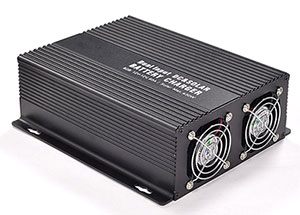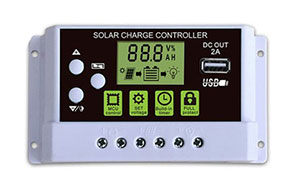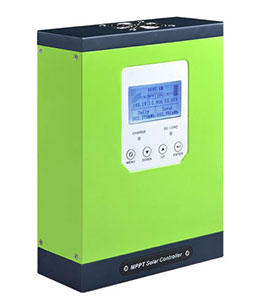The solar charge controller is an automatic control device used in the solar power generation system to control the multi-channel solar cell array to charge the battery. It regulates and controls the charging and discharging conditions of the battery, and controls the power output of the solar cell components and the battery to the load according to the power demand of the load. It is the core control part of the entire photovoltaic power supply system. There are three main types of popular solar charge controllers on the market: ordinary solar charge controllers, PWM solar charge controllers,s and MPPT solar charge controllers. Next, you can get more information about the three types and functions of solar charge controllers.
The function of the solar charge controller
The solar charge controller continuously switches and adjusts the working state of the battery pack according to the change in sunlight intensity and load, so that the battery can run alternately under various working conditions such as charging, discharging, or floating charging, so as to ensure the continuity and stability of the photovoltaic power station. In addition, solar charge controller also has a variety of protection and monitoring functions. By detecting the state of charge of the battery pack, it issues instructions to the battery pack to protect the battery pack from overcharging and discharging.
Ordinary Solar Charge Controller
The ordinary solar charge controller is an important part of the solar power generation system, which is used to control the charging of the battery by the multi-way solar cell array and the power supply from the battery to the solar inverter load. Ordinary solar charge controller is the first-generation technology. The working principle is to directly connect the output of the solar panel to the battery port. When the battery is full, it will be disconnected. Because of the internal resistance of the battery, it can’t be fully charged. So the solar panel is not fully utilized, and the charging conversion efficiency is only 70-76%. Nowadays, ordinary solar controllers have been eliminated from the market.
PWM Solar Charge Controller
The PWM solar charge controller uses the digital output of the microprocessor to control the analog circuit. This is a method of digitally encoding the analog signal level. Specifically, it divides the waveform into several equal parts (such as 6 equal parts) and replaces them with multiple square waves to achieve digital control of the analog circuit. This method can greatly reduce the cost and power consumption of the system. Compared with ordinary solar controllers, PWM solar charge controllers have made a lot of progress and can solve the problem of battery dissatisfaction. Its charging conversion efficiency is 75-80%, but the solar panels are still not fully utilized.
MPPT Solar Charge Controller
MPPT solar charge controller is the third-generation technology and the most high-end solar controller. MPPT solar charge controller refers to a solar controller with a maximum power point tracking function, which is an upgraded product of the PWM solar charge controller. The maximum power point tracking system is an electrical system that enables the solar panel to output more electrical energy by adjusting the working state of the electrical module and can effectively store the DC power emitted by the solar panel in the battery. The MPPT controller can detect the power generation voltage of the solar panel in real-time, and track the highest voltage and current value (VI) so that the system can charge the battery with the maximum power output.
MPPT solar charge controllers offer significant advantages in terms of efficiency, performance, and flexibility for solar power systems. They are ideal for larger installations or situations where maximizing the energy harvest from solar panels is crucial. While they come at a higher cost and complexity, the benefits of improved energy efficiency and battery life often justify the investment, especially for more demanding solar power applications.
The conversion rate of the MPPT controller to the solar panel is relatively high. When the sunshine changes frequently or in cloudy weather, it absorbs at least 30% more power than the PWM controller. It is the best controller solution for the power generation efficiency of the current off-grid system.
